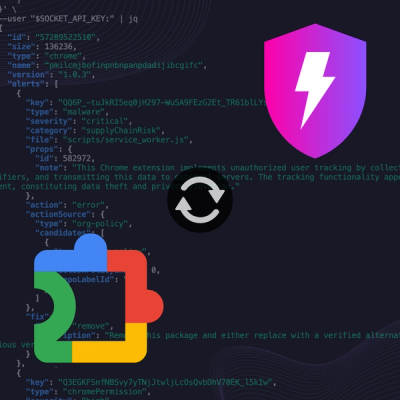
Product
Socket Now Protects the Chrome Extension Ecosystem
Socket is launching experimental protection for Chrome extensions, scanning for malware and risky permissions to prevent silent supply chain attacks.
@tripsuite/cxml
Advanced tools

cxml aims to be the most advanced schema-aware streaming XML parser for JavaScript and TypeScript.
It fully supports namespaces, derived types and substitution groups.
It can handle pretty hairy schema such as
GML,
WFS and extensions to them defined by
INSPIRE.
Output is fully typed and structured according to the actual meaning of input data, as defined in the schema.
For example this XML:
<dir name="123">
<owner>me</owner>
<file name="test" size="123">
data
</file>
</dir>
can become this JSON (run npm test to see it happen):
{
"dir": {
"name": "123",
"owner": "me",
"file": [
{
"name": "test",
"size": 123,
"content": "data"
}
]
}
}
Note the following:
"123" can be a string or a number depending on the context.name attribute and owner child element are represented in the same way.dir has a single owner but can contain many files, so file is an array but owner is not.See the example schema
that makes it happen. Schemas for formats like
GML and
SVG are nastier,
but you don't have to look at them to use them through cxml.
Relevant schema files should be downloaded and compiled using cxsd before using them to parse documents. Check out the example schema converted to TypeScript.
There's much more. What if we parse an empty dir:
import * as cxml from 'cxml';
import * as example from 'cxml/test/xmlns/dir-example';
var parser = new cxml.Parser();
var result = parser.parse('<dir name="empty"></dir>', example.document);
Now we can print the result and try some magical features:
result.then((doc: example.document) => {
console.log( JSON.stringify(doc) ); // {"dir":{"name":"empty"}}
var dir = doc.dir;
console.log( dir instanceof example.document.dir.constructor ); // true
console.log( dir instanceof example.document.file.constructor ); // false
console.log( dir instanceof example.DirType ); // true
console.log( dir instanceof example.FileType ); // false
console.log( dir._exists ); // true
console.log( dir.file[0]._exists ); // false (not an error!)
});
Unseen in the JSON output, every object is an instance of a constructor for the appropriate XSD schema type.
Its prototype also contains placeholders for valid children, which means you can refer to a.b.c.d._exists even if a.b doesn't exist.
This saves irrelevant checks when only the existence of a deeply nested item is interesting.
The magical _exists flag is true in the prototypes and false in the placeholder instances, so it consumes no memory per object.
We can also process data as soon as the parser sees it in the incoming stream:
parser.attach(class DirHandler extends (example.document.dir.constructor) {
/** Fires when the opening <dir> and attributes have been parsed. */
_before() {
console.log('Before ' + this.name + ': ' + JSON.stringify(this));
}
/** Fires when the closing </dir> and children have been parsed. */
_after() {
console.log('After ' + this.name + ': ' + JSON.stringify(this));
}
});
The best part: your code is fully typed with comments pulled from the schema! See the screenshot at the top.
Copyright (c) 2016 BusFaster Ltd
FAQs
Advanced schema-aware streaming XML parser
We found that @tripsuite/cxml demonstrated a not healthy version release cadence and project activity because the last version was released a year ago. It has 1 open source maintainer collaborating on the project.
Did you know?

Socket for GitHub automatically highlights issues in each pull request and monitors the health of all your open source dependencies. Discover the contents of your packages and block harmful activity before you install or update your dependencies.

Product
Socket is launching experimental protection for Chrome extensions, scanning for malware and risky permissions to prevent silent supply chain attacks.

Product
Add secure dependency scanning to Claude Desktop with Socket MCP, a one-click extension that keeps your coding conversations safe from malicious packages.

Product
Socket now supports Scala and Kotlin, bringing AI-powered threat detection to JVM projects with easy manifest generation and fast, accurate scans.